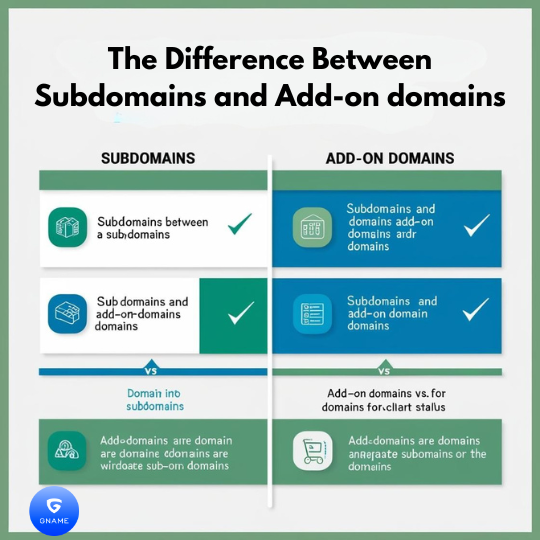When it comes to building an online presence, understanding the different types of domains available is crucial. Two common options are subdomains and add-on domains. While they may seem similar at first glance, they serve different purposes and have distinct advantages and disadvantages. In this blog post, we'll explore the key differences between subdomains and add-on domains, their use cases, and best practices for selecting the right option for your website.

Get $7.89 off .COM registration and $5 off transfers—exclusive for new users at GNAME! Sign up now and save!
What is a Subdomain?
A subdomain is a division of a main domain that allows you to create a separate section of your website. It is prefixed to the main domain name, separated by a dot. For example, if your main domain is "example.com," a subdomain could be "blog.example.com" or "store.example.com." Subdomains are typically used to organize content or create dedicated areas for specific topics, services, or functionalities.
Advantages of Subdomains
Organizational Structure
Subdomains can help you create a clear structure for your website. For example, if you have a blog, an online store, and a portfolio, using subdomains can help visitors navigate more easily.
SEO Benefits
Search engines treat subdomains as separate entities. This means that you can optimize each subdomain for specific keywords, potentially improving your search engine rankings for different topics.
Flexibility
Subdomains allow you to use different content management systems (CMS) or frameworks for different sections of your site. For instance, you could run your main website on WordPress and your blog on a different platform.
Disadvantages of Subdomains
Branding Confusion
Subdomains may lead to brand confusion if not managed properly. Users might not immediately associate the subdomain with your main brand, especially if the content differs significantly.
Link Equity
While subdomains can boost SEO, they may not benefit from the same link equity as the main domain. This means that any backlinks to a subdomain may not contribute as much to the overall authority of the main site.
What is an Add-on Domain?
An add-on domain is a separate domain that is added to your existing hosting account. Unlike subdomains, add-on domains function as entirely independent websites. For instance, if you own "example.com" and want to create a new website called "newsite.com," you can add "newsite.com" as an add-on domain. Each add-on domain can have its own content, design, and functionality.
Advantages of Add-on Domains
Complete Independence
Add-on domains allow you to create a fully independent website with its own branding, design, and content. This is ideal for businesses or projects that require a distinct online presence.
SEO Potential
Since add-on domains are treated as separate entities by search engines, they can be optimized independently. This means you have the flexibility to target different keywords and audiences.
Easier Management for Multiple Sites
If you manage multiple websites, using add-on domains can simplify your hosting management. You can host multiple domains under a single account, making it easier to handle billing and updates.
Disadvantages of Add-on Domains
Increased Costs
Each add-on domain may require its own registration, which can increase costs compared to using subdomains. Additionally, you may need to invest in separate SSL certificates for each domain.
Time-Consuming Setup
Setting up and managing multiple add-on domains can be more time-consuming than subdomains, especially if you need to create and maintain separate websites.
When to Use Subdomains vs. Add-on Domains
The choice between subdomains and add-on domains ultimately depends on your goals and the structure of your online presence. Here are some scenarios to consider:
Use Subdomains When:
- You want to organize content within your main website.
- You need to create dedicated areas for different topics.
- You want to maintain a cohesive brand identity across different sections.
Use Add-on Domains When:
- You are launching a completely new website with its own branding and purpose.
- You want to manage multiple independent sites under one hosting account.
- You need to target different audiences with separate content strategies.
Understanding the differences between subdomains and add-on domains is vital for anyone looking to establish a strong online presence. By evaluating your specific needs, you can make an informed decision that aligns with your goals. Whether you choose to use subdomains for better organization or add-on domains for complete independence, both options offer unique advantages that can enhance your website's effectiveness.





















